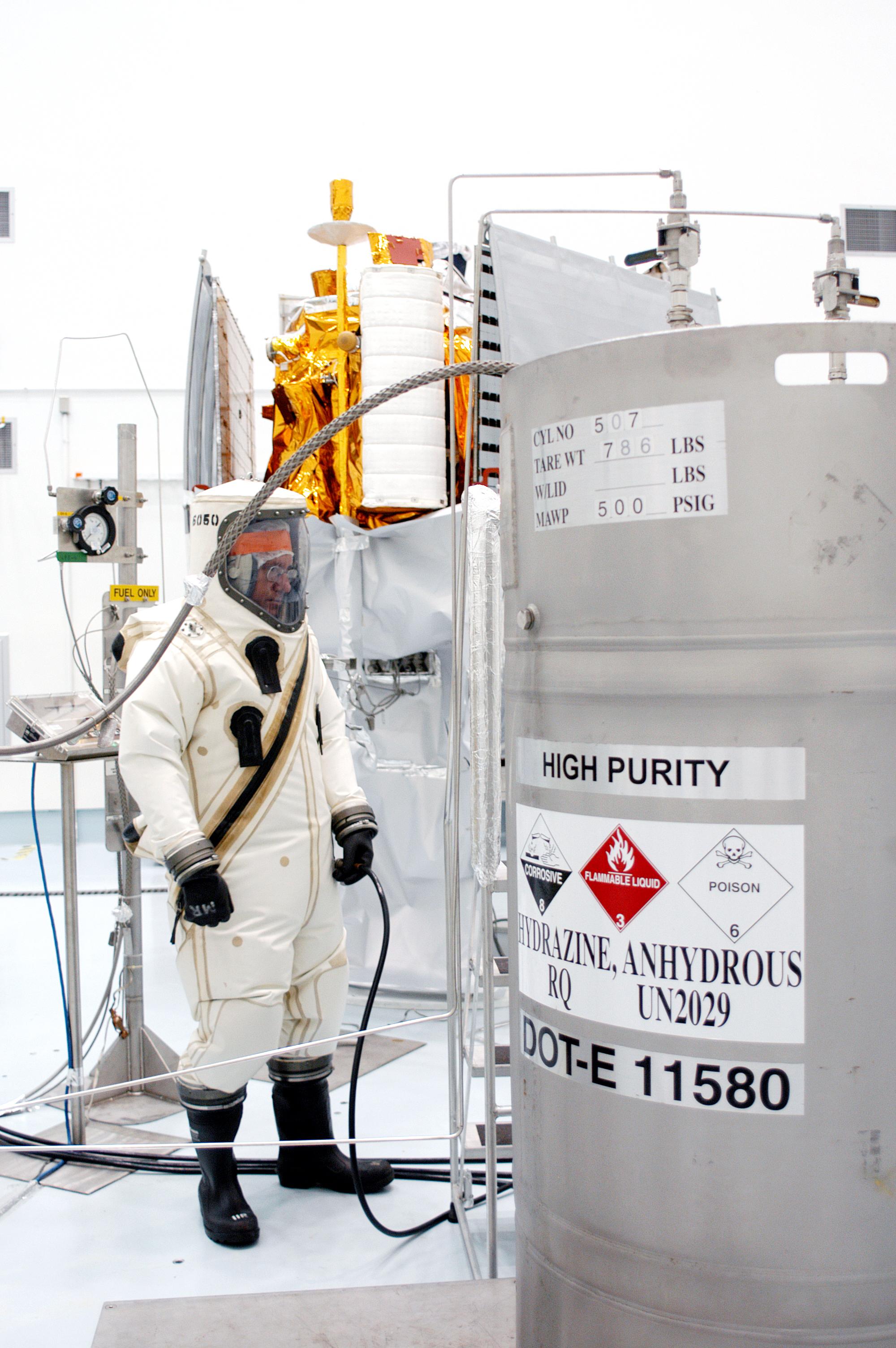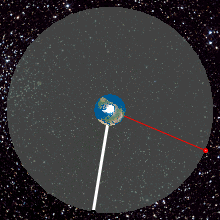|
Yuanzheng-1
Yuanzheng () is a restartable upper stage developed by the China Academy of Launch Vehicle Technology (CALT) for the Long March rocket family. The Yuanzheng stage enables the Chinese launch vehicles to deploy payloads directly to high-energy orbits such as medium Earth orbit (MEO) and geosynchronous orbit (GSO). Since the Long March third stage cannot restart, it cannot circularize a GSO or GEO orbit from a geosyncronous transfer orbit ( GTO). With its restart capability, Yuanzheng has enabled the deployment of satellite pairs for the BeiDou Navigation Satellite System in MEO and communications satellites in GSO. This eliminates the need for the spacecraft to include a liquid apogee engine or an apogee kick motor. Yuanzheng has a thrust of with a specific impulse of 315.5 seconds. It uses the storable hypergolic propellants unsymmetrical dimethylhydrazine (UDMH) and dinitrogen tetroxide (), and can perform at least two burns within its rated life of 6.5 hours, sufficient to ... [...More Info...] [...Related Items...] OR: [Wikipedia] [Google] [Baidu] |
Long March 7
The Long March 7 (), or Chang Zheng 7 in pinyin, abbreviated LM-7 for export or CZ-7 within China, originally Long March 2F/H or Chang Zheng 2F/H, nicknamed Bingjian (), is a Chinese liquid-fuelled launch vehicle of the Long March family, developed by the China Aerospace Science and Technology Corporation (CAST). It made its inaugural flight on 25 June 2016. Designed as a replacement of the Long March 2F, Long March 7 and its variants was expected to be the workhorse of the fleet, projected to account for around 70% of all Chinese launches. Long March 7 plays a critical role in the Chinese Space Station program: it is used to launch the Tianzhou robotic cargo and resupply spacecraft to the station. The rocket was intended to replace the Long March 2F as China's crew-rated launch vehicle in the future, although by 2023 this role has apparently been taken over by the under-development Long March 10 and Long March 10A. Since 2020, in addition to the base Long March 7 config ... [...More Info...] [...Related Items...] OR: [Wikipedia] [Google] [Baidu] |
Long March 3B
The Long March 3B (), also known as the CZ-3B and LM-3B, is a Chinese orbital launch vehicle. Introduced in 1996, it is launched from Launch Area 2 and 3 at the Xichang Satellite Launch Center in Sichuan. A three-stage rocket with four strap-on liquid rocket boosters, it is the heaviest variant of the Long March 3 rocket family, and is mainly used to place communications satellites and navigation satellites into geosynchronous orbits. An enhanced version, the Long March 3B/E or G2, was introduced in 2007 to increase the rocket's geostationary transfer orbit (GTO) cargo capacity and lift heavier geosynchronous orbit (GEO) communications satellites. The Long March 3B also served as the basis for the medium-capacity Long March 3C, which was first launched in 2008. , the Long March 3B, 3B/E and 3B/G5 have conducted 105 successful launches, plus 2 failures and 2 partial failures, accumulating a success rate of . It is the first Long March (rocket family), Long March series rocket t ... [...More Info...] [...Related Items...] OR: [Wikipedia] [Google] [Baidu] |
Long March 2D
The Long March 2D (), also known as the Chang Zheng 2D, CZ-2D, and LM-2D, is a Chinese two-stage orbital carrier rocket mainly used for launching LEO and SSO satellites. It is manufactured by the Shanghai Academy of Spaceflight Technology (SAST). It is mainly launched from areas LA-2B and LA-4 at the Jiuquan Satellite Launch Center. The Long March 2D made its maiden flight on 9 August 1992. It was initially used to launch FSW-2 and FSW-3 reconnaissance satellites. More recently it has also launched from LA-9 TSLC and LA-3 XSLC. Unlike all other members of the Long March 2 Long March 2 rocket family or Chang Zheng 2 rocket family as in Chinese pinyin is an expendable launch system operated by the People's Republic of China. The rockets use the abbreviations LM-2 family for export, and CZ-2 family within Chi ... rocket family, the Long March 2D is a two-stage version of the Long March 4 launch vehicle. Launch statistics List of launches The Long March ... [...More Info...] [...Related Items...] OR: [Wikipedia] [Google] [Baidu] |
Apogee Kick Motor
An apogee kick motor (AKM) is a rocket motor that is regularly employed on artificial satellites to provide the final impulse to change the trajectory from the transfer orbit into its final orbit (most commonly circular). For a satellite launched from the Earth, the rocket firing is done at the highest point of the transfer orbit, known as the apogee. An apogee kick motor is used, for example, for satellites launched into a geostationary orbit. As the vast majority of geostationary satellite launches are carried out from spaceports at a significant distance away from Earth's equator, the carrier rocket often only launches the satellite into an orbit with a non-zero inclination approximately equal to the latitude of the launch site. This orbit is commonly known as a "geostationary transfer orbit" or a "geosynchronous transfer orbit". The satellite must then provide thrust to bring forth the needed delta v to reach a geostationary orbit. This is typically done with a fixed onbo ... [...More Info...] [...Related Items...] OR: [Wikipedia] [Google] [Baidu] |
Specific Impulse
Specific impulse (usually abbreviated ) is a measure of how efficiently a reaction mass engine, such as a rocket engine, rocket using propellant or a jet engine using fuel, generates thrust. In general, this is a ratio of the ''Impulse (physics), impulse'', i.e. change in momentum, ''per mass'' of propellant. This is equivalent to "thrust per massflow". The resulting unit is equivalent to velocity. If the engine expels mass at a constant exhaust velocity v_e then the thrust will be \mathbf = v_e \frac . If we integrate over time to get the total change in momentum, and then divide by the mass, we see that the specific impulse is equal to the exhaust velocity v_e . In practice, the specific impulse is usually lower than the actual physical exhaust velocity inefficiencies in the rocket, and thus corresponds to an "effective" exhaust velocity. That is, the specific impulse I_ in units of velocity *is defined by* : \mathbf = I_ \frac , where \mathbf is the average thrust. ... [...More Info...] [...Related Items...] OR: [Wikipedia] [Google] [Baidu] |
Hypergolic
A hypergolic propellant is a rocket propellant combination used in a rocket engine, whose components spontaneously ignite when they come into contact with each other. The two propellant components usually consist of a fuel and an oxidizer. The main advantages of hypergolic propellants are that they can be stored as liquids at room temperature and that engines which are powered by them are easy to ignite reliably and repeatedly. Common hypergolic propellants are extremely toxic or corrosive, making them difficult to handle. In contemporary usage, the terms "hypergol" and "hypergolic propellant" usually mean the most common such propellant combination: dinitrogen tetroxide plus hydrazine. History The fact that turpentine may spontaneously combust when mixed with nitric acid was discovered as early as the late 17th century by Frederick Slare, but it remained a scientific curiosity for centuries until it was proposed to use it for rocket-assisted take off during WWII. In 1935, ... [...More Info...] [...Related Items...] OR: [Wikipedia] [Google] [Baidu] |
Unsymmetrical Dimethylhydrazine
Unsymmetrical dimethylhydrazine (abbreviated as UDMH; also known as 1,1-dimethylhydrazine, heptyl or Geptil) is a chemical compound with the formula H2NN(CH3)2 that is primarily used as a rocket propellant. At room temperature, UDMH is a colorless liquid, with a sharp, fishy, ammonia-like smell typical of organic amines. Samples turn yellowish on exposure to air and absorb oxygen and carbon dioxide. It is miscible with water, ethanol, and kerosene. At concentrations between 2.5% and 95% in air, its vapors are flammable. It is not sensitive to shock. Symmetrical dimethylhydrazine (1,2-dimethylhydrazine) also exists, but it is not as useful. UDMH can be oxidized in air to form many different substances, including toxic ones. Synthesis In 1875, UDMH was first prepared by Emil Fischer, who discovered and named the class of hydrazines, by reducing N-Nitrosodimethylamine with zinc in boiling acetic acid. Fischer's student Edward Renouf later studied UDMH more extensively as part ... [...More Info...] [...Related Items...] OR: [Wikipedia] [Google] [Baidu] |
China Academy Of Launch Vehicle Technology
The China Academy of Launch Vehicle Technology (CALT) is a major state-owned civilian and military space launch vehicle manufacturer in China and one of the major launch service providers in the world. CALT is a subsidiary of the larger China Aerospace Science and Technology Corporation (CASC). It was established in 1957 by Dr. Xue-Sen Qian and is headquartered in Fengtai District, Beijing. Its major contribution to China's civilian and military launch capability has been the manufacture of the Long March family of rockets. CALT has over 33,000 employees. The current Chief Designer is Long Lehao (). CALT is also planning two spaceplanes. They would both be single-stage to space sub-orbital rocketplanes. One would be a 10-ton 4-passenger plane that would fly to 100 km at Mach 6. The other would be a 100-ton 20-passenger plane that would fly to 130 km at Mach 8. They would be equipped with liquid methane/liquid oxygen rocket engines. The larger spaceplane would also ... [...More Info...] [...Related Items...] OR: [Wikipedia] [Google] [Baidu] |
Dinitrogen Tetroxide
Dinitrogen tetroxide, commonly referred to as nitrogen tetroxide (NTO), and occasionally (usually among ex-USSR/Russian rocket engineers) as amyl, is the chemical compound N2O4. It is a useful reagent in chemical synthesis. It forms an equilibrium mixture with nitrogen dioxide. Its molar mass is 92.011 g/mol. Dinitrogen tetroxide is a powerful oxidizer that is hypergolic (spontaneously reacts) upon contact with various forms of hydrazine, which has made the pair a common bipropellant for rockets. Structure and properties Dinitrogen tetroxide could be regarded as two nitro groups (-NO2) bonded together. It forms an equilibrium mixture with nitrogen dioxide. The molecule is planar with an N-N bond distance of 1.78Å and N-O distances of 1.19Å. The N-N distance corresponds to a weak bond, since it is significantly longer than the average N-N single bond length of 1.45Å. This exceptionally weak σ bond (amounting to overlapping of the ''sp''2 hybrid orbitals of the two NO2 uni ... [...More Info...] [...Related Items...] OR: [Wikipedia] [Google] [Baidu] |
Geostationary Orbit
A geostationary orbit, also referred to as a geosynchronous equatorial orbit''Geostationary orbit'' and ''Geosynchronous (equatorial) orbit'' are used somewhat interchangeably in sources. (GEO), is a circular orbit, circular geosynchronous orbit in altitude above Earth's equator, in radius from Earth's center, and following the retrograde and prograde motion, direction of Earth's rotation. An object in such an orbit has an orbital period equal to Earth's rotational period, one sidereal time, sidereal day, and so to ground observers it appears motionless, in a fixed position in the sky. The concept of a geostationary orbit was popularised by the science fiction writer Arthur C. Clarke in the 1940s as a way to revolutionise telecommunications, and the first satellite to be placed in this kind of orbit was launched in 1963. Communications satellites are often placed in a geostationary orbit so that Earth-based satellite dish, satellite antennas do not have to rotate to track t ... [...More Info...] [...Related Items...] OR: [Wikipedia] [Google] [Baidu] |





